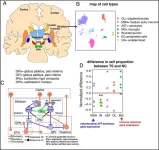(Press-News.org) Though the sense of touch underlies how we and most other animals interact with the world around us, much remains unknown about how this sense is processed in the brain. Researchers from Heidelberg University and Ludwig Maximillan University Munich in Germany measured the neuronal activity differences between active touch and passive touch in mice. As reported April 8th in the open-access journal, PLOS Biology, the researchers find that active and passive touch are processed by different pathways in the brain.
Active touch can be thought of as grabbing something with your hand, while passive touch would be something brushing against you. Mice, as well as many other animals, use their whiskers to sense the world around them, much like how we use our fingertips. To actively touch something, mice move their whiskers around, “whisking” the object they are investigating. They also passively sense touch through their whiskers when an object touches them.
The researchers measured whisker movement and neuronal activity in the mice, focusing on the thalamus, the part of the brain that processes all senses except for smell. The mice either actively interacted with an object or the researchers delivered a puff of air to passively stimulate the whiskers.
The baseline activity of the thalamus was generally higher before the mice engaged in active touching, and one part of the thalamus responded to both active and passive touch. However, another part called the posterior medial thalamus primarily responded to passive touch. This region also had the highest activity when long intervals had passed between puffs of air, which the researchers propose may be connected to the mouse’s surprise at the touch.
Touch is important for many essential activities from finding food to social interaction. Passive touch, in particular, can also help animals sense danger, such as a predator lurking nearby. Processing these types of touch in different regions of the brain may allow animals to respond quickly and appropriately in their natural environments.
The authors add, “Being touched and touching something can lead to the same primary sensation but mean entirely different things. We explored how active and passive touch are represented differently in the brain and find that the higher-order thalamus (POm) strongly differentiates these situations.”
In your coverage, please use this URL to provide access to the freely available paper in PLOS Biology: https://plos.io/3DAPo7L
Citation: Sumser A, Isaías-Camacho EU, Mease RA, Groh A (2025) Active and passive touch are differentially represented in the mouse somatosensory thalamus. PLoS Biol 23(4): e3003108. https://doi.org/10.1371/journal.pbio.3003108
Author countries: Germany
Funding: see manuscript
END
Mouse brains register the difference between touching something and being touched
Researchers find active and passive touch activate different regions of the brain in mice, which may help these creatures better navigate their environments
2025-04-08
ELSE PRESS RELEASES FROM THIS DATE:
Researchers identify safer pathway for pain relief
2025-04-08
University of Florida scientists have helped identify a novel drug compound that selectively activates pain-altering receptors in the body, offering a potentially safer alternative to conventional pain medications.
In a new study published in Nature Communications, researchers describe how this drug compound provides pain relief without the dangerous side effects commonly associated with opioids administered to patients. The National Institutes of Health funded the study.
The human body relies on three kinds of opioid receptors to regulate pain, much like traffic control systems on a busy highway. Understanding these pathways ...
Cleveland Clinic-led trial is the first to show a delay in confirmed disability progression in non-relapsing secondary progressive multiple sclerosis
2025-04-08
Tuesday, April 8, 2025, Cleveland: A Cleveland Clinic-led clinical trial of tolebrutinib, an investigational oral Bruton’s tyrosine kinase inhibitor, a group of drugs originally developed to treat lymphomas and related blood disorders, demonstrated a 31% delay in the onset of six-month confirmed disability progression (CDP) in patients with non-relapsing secondary progressive multiple sclerosis (SPMS).
The first peer-reviewed results of the Phase 3 HERCULES trial published online today in the New England Journal of Medicine and were simultaneously presented during a clinical trials plenary session at the American Academy of Neurology 2025 ...
Community Review Board votes against public health care merger in Oregon after doctors group raises concerns about university’s primate research center
2025-04-08
PORTLAND, Ore. — The Physicians Committee for Responsible Medicine is lauding a Community Review Board after it voted unanimously on Monday to reject a merger between Oregon Health & Science University (OHSU), which houses one of seven primate research centers left in the United States, and Legacy Health.
“Instead of showing a real focus on patient care and ethical behavior, OHSU has been wasting money on drug, alcohol, and sex experiments on monkeys, and the public knows it,” said Neal Barnard, MD, FACC, ...
Groundbreaking study reveals changes in brain cell composition and gene activity in Tourette syndrome
2025-04-08
Philadelphia, April 8, 2025 – In the first comprehensive, cell-by-cell analysis of brain tissue from individuals with Tourette syndrome, researchers have pinpointed exactly which cells are perturbed and how they malfunction, revealing how different types of brain cells are affected by the condition. Findings from this groundbreaking study in Biological Psychiatry, published by Elsevier, provide unprecedented insights into the interplay of different brain cell types in Tourette syndrome, suggesting new therapeutic directions.
What makes this study particularly groundbreaking ...
ALS drug effectively treats Alzheimer’s disease in new animal study
2025-04-08
Experimental drug NU-9 — a small molecule compound approved by the U.S. Food and Drug Administration (FDA) for clinical trials for the treatment of amyotrophic lateral sclerosis (ALS) — improves neuron health in animal models of Alzheimer’s disease, according to a new Northwestern University study.
Like ALS, Alzheimer’s disease also results from misfolded proteins that damage brain health. Rather than treating symptoms from specific diseases, NU-9 instead addresses the underlying mechanisms of disease. Results from the new study give scientists hope that the drug should demonstrate effectiveness in the common ...
Breakthrough research revolutionizing pulmonary hypertension treatment
2025-04-08
A recent publication in the International Journal of Cardiology, Pulmonary artery denervation in pulmonary hypertension: A comprehensive meta-analysis, has shed light on the potential of pulmonary artery denervation (PADN) as an innovative intervention for pulmonary hypertension (PH), a condition that places patients at risk for right heart failure and death. Co-authored by Dr. James Jenkins, a cardiologist at Ochsner Health, the study analyzed data from multiple clinical trials to assess the therapeutic and clinical impact of PADN ...
More CPR education planned for Charlotte community with The David & Nicole Tepper Foundation
2025-04-08
CHARLOTTE, April 8, 2025 — The American Heart Association and The David & Nicole Tepper Foundation (DNTF) have teamed up to increase bystander cardiopulmonary resuscitation (CPR) and automated external defibrillator (AED) education through the Association’s Nation of Lifesavers™ movement. DNTF’s $600,000 commitment to support training in Charlotte youth sports will help prepare coaches, athletes and sports leagues officials to respond immediately and appropriately in a cardiac emergency situation. DNTF’s gift will also support CPR education within the Mecklenburg County Sheriff’s Department as well as affordable housing communities.
“This ...
When protective lipids decline, health risks increase
2025-04-08
New research from Weill Cornell Medicine has uncovered a surprising culprit underlying cardiovascular diseases in obesity and diabetes—not the presence of certain fats, but their suppression. The study, published Feb. 25 in Nature Communications, challenges the conventional belief that a type of fat called ceramides accumulates in blood vessels causing inflammation and health risks. Instead, their findings reveal that when ceramides decrease in endothelial cells lining blood vessels, it can be damaging and cause chronic illnesses. Ironically, the findings ...
Society for Laboratory Automation and Screening announces $100,000 Graduate Education Fellowship Grant awarded to Vasu Rao of the University of Michigan
2025-04-08
Oak Brook, IL (USA) – The Society for Laboratory Automation and Screening (SLAS) is pleased to announce Vasumitra “Vasu” Rao, M.S., Ph.D. candidate in the Biomedical Engineering program at the University of Michigan (Ann Arbor, Michigan, USA), as the 2025 SLAS Graduate Education Fellowship Grant recipient.
Rao’s innovative work at the intersection of artificial intelligence (AI), laboratory automation and microbiology exemplifies SLAS’s mission to support emerging leaders in quantitative biosciences through the grant.
The awarded funding will enable Rao to continue his research under advisor Paul Jensen, Ph.D. (Assistant Professor of Biomedical Engineering) ...
World’s largest study reveals the long-term health impacts of flooding
2025-04-08
WORLD’S LARGEST STUDY REVEALS THE LONG-TERM HEALTH IMPACTS OF FLOODING
The world’s largest and most comprehensive study of the long-term health impacts of flooding – via analysis of over 300 million hospitalizations records in eight countries prone to flooding events – has found an increased risk of 26 per cent of all diseases serious enough to require hospitalization. This impact on the health of communities lasts up to seven months post event.
The study, led by Monash University researchers, and published in the journal, Nature Water, found that flooding events – which are increasing globally due to climate change ...
LAST 30 PRESS RELEASES:
Norbert Holtkamp appointed director of Fermi National Accelerator Laboratory
New agentic AI platform accelerates advanced optics design
Biologists discover neurons use physical signals — not electricity — to stabilize communication
Researchers discover that a hormone can access the brain by hitchhiking
University of Oklahoma researcher awarded funding to pursue AI-powered material design
Exploring how the visual system recovers following injury
Support for parents with infants at pediatric check-ups leads to better reading and math skills in elementary school
Kids’ behavioral health is a growing share of family health costs
Day & night: Cancer disrupts the brain’s natural rhythm
COVID-19 vaccination significantly reduces risk to pregnant women and baby
The role of vaccination in maternal and perinatal outcomes associated with COVID-19 in pregnancy
Mayo Clinic smartwatch system helps parents shorten and defuse children's severe tantrums early
Behavioral health spending spikes to 40% of all children’s health expenditures, nearly doubling in a decade
Digital cognitive behavioral treatment for generalized anxiety disorder
Expenditures for pediatric behavioral health care over time and estimated family financial burden
Air conditioning in nursing homes and mortality during extreme heat
The Alps to lose a record number of glaciers in the next decade
What makes a good proton conductor?
New science reporting guide published for journalists in Bulgaria
New international study reveals major survival gaps among children with cancer
New science reporting guide published for journalists in Turkey
Scientists develop a smarter mRNA therapy that knows which cells to target
Neuroanatomy-informed brain–machine hybrid intelligence for robust acoustic target detection
Eight SwRI hydrogen projects funded by ENERGYWERX
The Lundquist Institute and its start-up company Vitalex Biosciences Announces Strategic Advancement of Second-Generation fungal Vaccine VXV-01 through Phase 1 Trials under $40 Million Competitive Con
Fine particles in pollution are associated with early signs of autoimmune disease
Review article | Towards a Global Ground-Based Earth Observatory (GGBEO): Leveraging existing systems and networks
Penn and UMich create world’s smallest programmable, autonomous robots
Cleveland researchers launch first major study to address ‘hidden performance killer’ in athletes
To connect across politics, try saying what you oppose
[Press-News.org] Mouse brains register the difference between touching something and being touchedResearchers find active and passive touch activate different regions of the brain in mice, which may help these creatures better navigate their environments




